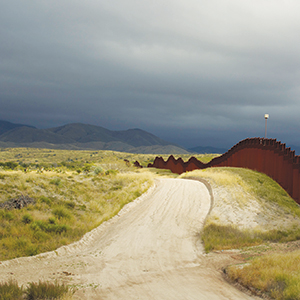

The call and response of photographer to composer and back again informs the collaboration of Border Cantos. The photographer is Richard Misrach; the composer Guillermo Galindo. The subject is the border between the United States and Mexico.
With his snapshots, Misrach captures the vast desert expanses, along with the fences and walls that divide the two countries. Galindo composes sonic landscapes using one-of-a-kind, hand-made musical instruments, which he has fashioned from various materials and personal objects found strewn about the scrubby, wind-swept terrain that straddles the border.
The exhibit explores the geographical, political and psychological ramifications of life on the border. Through photography and music, both artists aim to accurately reflect life in this transitory zone—showcasing its beauty as well as its dark side and documenting the dangers inherent in attempting to cross from one side to the other.
In Misrach’s unassuming Berkeley studio, he and Galindo discuss the details of the project’s inception. Misrach’s initial project Desert Cantos began 40 years. During regular visits to the border states of California, Arizona, New Mexico and Texas, he began to find a variety of objects that piqued his interest, concern and curiosity: a water station marked “agua” in the middle of nowhere; border patrol shotgun shells; disembodied sections of the border walls; tires and chains.
The evidence of migrants, humanitarian groups and border enforcement all got Misrach thinking: “What’s going on here?” In 2009, at the same time he was noticing that immigration authorities were ramping up construction efforts along the border, he also started to see a strange series of figures planted in an area surrounding the California town of Jacumba. Misrach calls them “effigies.”
At first glance, the figures in this series of photographs look like headless scarecrows. And then on closer inspection, the optic nerve sends a warning to the brain. There is something deeply unsettling about the “X” made of branches or tree limbs and the long sticks that hold up the hollowed out clothing in the shape of men. Not only do they call to mind crucifixion; they also hold an eldritch energy that appears both religious and anti-religious at the same time. An empty numbered football jersey has never been more menacing or forlorn.
In the sound room of the gallery at the exhibit where one of the effigy portraits hangs on the wall, one of Galindo’s tracks permeates the air.
These soundscapes were created with an assortment items—all of them thrown away or lost by the people who frequent these crossings. In the recordings and corresponding videos Galindo bangs on scraps of metal and wood; scratches at abandoned shoes and drags them through sand; he plucks the few remaining teeth of an old pink comb; and creates forlorn chords by blowing across the tops of an empty half pint of liquor and dusty soda bottle.
By incorporating the shotgun shells, tires, and discarded or abandoned clothing into a reconceived erhu or zapatel, Galindo draws attention to the actual human element of those border crossings.The objects, Galindo explains “give a voice to the people that once owned them. They tell stories about their journeys in sound.”
In other instances, Galindo plays much more complex contraptions, comprising a multitude of objects stitched together. One of the composer’s more striking creations, Zapatello, features two flat plywood boards, cut to resemble the silhouette of a man, which Galindo cranks in a circle. With each pass, the head of the target clacks against the jawbone of a bull and two large wooden joints raise a hiking boot and a disembodied glove—pulling them into the air and then bringing them back down again against the skin of a drum, which is stretched taut over a massive rubber tire.
“To me everything is a musical instrument,” Galindo says. “I don’t see any difference between a plastic bottle and a flute.” Furthermore, he adds, everything has a certain sonic quality that can tell the listener something about that object—including its intended purpose.
For example, Galindo continues, many of the objects that were left behind by the border patrol were large, heavy and made of dense materials, such as wood or metal. These objects produced deep, loud and sometimes fearsome sounds.
Galindo’s instruments work as a sonic equivalent to Misrach’s photographs. They act as companion and guide inside of these desert places. The composer says that he is working to create: visual sound.
“It’s kind of my idea of synesthesia,” he explains. Though, instead of translating color into sound, “it’s the translation and interpretation of visual art into sound”—namely the translation of Mirach’s photos into music.
Misrach is happy to provide the inspiration—and to take inspiration in return. In describing Galindo’s influence on his work, Misrach recalled visiting a place together on the Arizona border where, “the wind comes through a very sandy area. And there’s a bombing range nearby. The wall picks up the sounds of the bombing range, of the wind. It became sonic for me, which, in the past, it never would have been.”
Border Cantos
Thru Jul 31, $5-$10
San Jose Museum of Art


